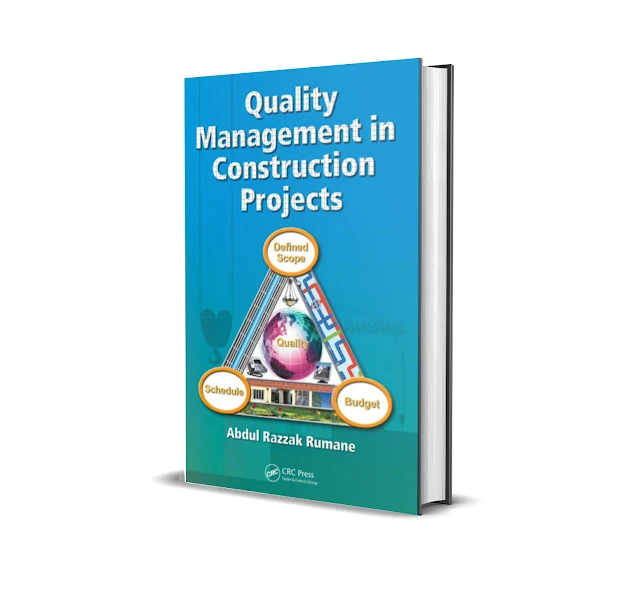Download Quality Management in Construction Projects Easily In PDF Format For Free.
PREFACE:
Quality is a universal phenomenon that has been a matter of great concern throughout recorded history. It was always the determination of builders and makers of products to ensure that their products meet the customer’s desire. With the advent of globalization and the competitive market, the emphasis on quality management has increased. Quality has become the most important single factor for the survival and success of today’s companies. Customer demands for better products and services at the lowest possible costs have put tremendous pressure on firms to improve the quality of products, services, and processes to compete in the market and improve business results. It became important that construction projects be more qualitative, competitive, and economical to meet owner’s expectations. Construction projects have the involvement of many participants including the owner, designer, contractor, and many other professionals from construction-related industries.
Each of these participants is involved in implementing quality in construction projects. These participants are both influenced by and depend on each other in addition to “other players” involved in the construction process. Therefore, the construction projects have become more complex and technical, and extensive efforts are required to reduce rework and costs associated with time, materials, and engineering. This book has been developed to provide significant information on quality issues to professional practitioners involved in construction projects (mainly civil construction projects and commercial/A&E projects) and constructionrelated industries, stressing the importance of quality, various quality control principles, procedures, concepts, methods, and tools and their applications to various activities/components/subsystems at different phases in the life cycle of a construction project to improve construction processes to conveniently manage projects and make them more qualitative, competitive, and economical. The book contains useful materials and information for students interested in acquiring knowledge about quality in the fields of construction projects, quality engineering, construction management, and project management.
The book will also provide specific information to academics about the practices followed in construction projects. The data discussed and derived in the book is from the author’s practical and professional experience in the construction field focusing on quality during the design and construction process. It also includes the reference writings of well-known quality “philosophers” whose work has dominated the quality movement. Their ideas and approaches to address specific quality issues have become part of accepted wisdom in the quality field.
The book contains many tables and figures to support the author’s writings and to make understanding of the subject easy. Different types of forms and transmittals used to plan, monitor, and control the project at different stages are included for the benefit of readers. Quality has been of great concern throughout the recorded history of human beings. Examples of specification and inspection can be found in the Bible dating back to at least 500 BCE. The desire for products that do as well or better than the customer’s needs and requirements has always been a constant in human history, matched only by the determination of builders and makers to meet that desire. Quality control was primarily carried out by inspection of goods before sale.
Growth of commerce and science and technology greatly expanded the extent and variety of nonnatural goods and services. With the advent of the Industrial Revolution, the situation changed dramatically. This period in history marked the beginning of quality control through inclusion of process in quality practices. The practices began to be employed consistently to meet higher standards. Quality concepts moved through different stages such as inspection, quality control, quality assurance, and total quality to reach the quality concept called Total Quality Management (TQM).
The value analysis concept started in the mid-1940s and also was applied in construction projects to improve the value of the project. Introduction of Six Sigma by Motorola in 1987 improved business results, and TRIZ methodology is used for generating innovative ideas for problem resolution, resulting in low-cost quality improvement solutions.
Continuous improvement in quality tools, techniques, and philosophies of quality management is taking place on a regular basis. Quality concepts, principles, methods, and processes, along with quality systems, environmental systems, and health and safety provisions, are integrated to create a new quality concept known as the Integrated Quality Management System. As product quality requirements rose, producers acquired greater skills in technical quality disciplines geared to technology and the product. Further, there was pressure to reduce the price to the consumer, and because of these economics, work became more competitive. Quality took a major step forward with the move from inspection to the concept of conformity to standards. Automation led to greater standardization.
For a number of years, the standards-based quality culture and the new concepts of continuous improvements, customer focus, and process control evolved. Thus, the quality concept started shifting from inspection to standardization and standardization to quality management.
The beginning of the 20th century marked inclusion of process in quality practices. Inspection and quality control teams assumed greater importance in production. Shewhart introduced the concept of statistical quality control (SQC) to quality problems. Quality control in this form was the norm in manufacturing until the early 1960s. Different types of control charts are being used for problem solving and continuous improvement of quality. This was followed by the concept of quality assurance.









Comments
Post a Comment